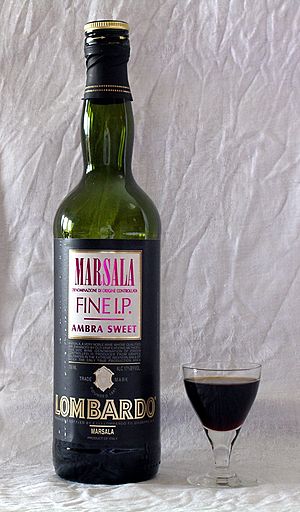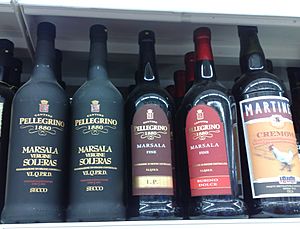Marsala wine facts for kids
Marsala is a special kind of fortified wine from the area around the city of Marsala in Sicily, Italy. Fortified wine means it has extra alcohol added to it. Marsala wine can be dry (not sweet) or sweet.
In 1969, Marsala wine received its first official status called Denominazione di Origine Controllata (DOC). This means its quality and origin are controlled. The European Union also gives Marsala a special status called Protected Designation of Origin (PDO). This helps make sure that only wine from the Marsala area can be called "Marsala."
Even though other wines are made in the Marsala region, only the fortified wine gets the official "Marsala" DOC status.
Contents
History of Marsala Wine
Marsala fortified wine became well-known outside Sicily thanks to an English trader named John Woodhouse. In 1773, he arrived at the port of Marsala. There, he discovered the local wine, which was aged in wooden barrels. It tasted a lot like the strong Spanish and Portuguese wines that were popular in England at the time.
Marsala wine was, and still is, made using a method called in perpetuum. This is similar to the solera system used for making Sherry wine in Spain. This process helps to increase the alcohol level and keep the wine tasting good for a long time.
Woodhouse realized that the in perpetuum process made the wine stronger and helped it stay fresh during long sea trips. He believed that this fortified Marsala wine would be very popular in England. He was right! Marsala became so successful that Woodhouse returned to Sicily. In 1796, he started making and selling it on a large scale.
Later, in 1806, Benjamin Ingham from England helped open new markets for Marsala wine across Europe and in the Americas. His family, including Joseph Whitaker, continued to run the business.
In 1833, a businessman named Vincenzo Florio bought land between the two biggest Marsala wine makers. He started making his own special wine. Florio later bought Woodhouse's company and other businesses in the late 1800s. He helped bring the Marsala wine industry together. Today, Florio and Pellegrino are still the main producers of Marsala wine.
What Makes Marsala Wine Special?
Marsala wine is made using white grapes like Grillo, Inzolia, and Catarratto. It usually contains about 15–20% alcohol.
Marsala wines are sorted into different types based on their color, how sweet they are, and how long they have been aged.
Sweetness Levels
There are three main levels of sweetness for Marsala wine:
- Secco: This means "dry." It has a maximum of 40 grams of sugar per liter.
- Semisecco: This means "semi-dry." It has between 41 and 100 grams of sugar per liter.
- Sweet: This means it has more than 100 grams of sugar per liter.
Colors of Marsala Wine
Marsala wine comes in different colors:
- Oro: This type has a beautiful golden color.
- Ambra: This type has an amber (yellow-brown) color. This color comes from a special sweetener called mosto cotto that is added to the wine.
- Rubino: This type has a ruby (red) color. It is made from red grape varieties like Perricone and Nero d'Avola.
How Long Marsala Wine is Aged
The aging process also gives Marsala wine different names:
- Fine: Aged for at least one year.
- Superiore: Aged for at least two years.
- Superiore Riserva: Aged for at least four years.
- Vergine and/or Soleras: Aged for at least five years.
- Vergine and/or Soleras Stravecchio and Vergine and/or Soleras Riserva: Aged for at least ten years.
Marsala wine was traditionally served as an aperitif. This is a drink served before a meal. Today, drier Marsala wines are often served chilled with strong cheeses like Parmesan or Gorgonzola. Sweeter Marsala wines are usually served at room temperature as a dessert wine.
Marsala Wine in Cooking
Marsala wine is often used in cooking, especially in Italian restaurants in the United States.
Dry Marsala wine is used in savory (not sweet) dishes. For example, a common Marsala sauce is made by cooking the wine down with onions or shallots until it becomes a thick syrup. Then, mushrooms and herbs are added.
One of the most famous recipes is chicken marsala. In this dish, pieces of chicken breast are cooked in a mixture of Marsala wine, butter, olive oil, mushrooms, and spices. Marsala is also used in some risotto recipes.
Sweet Marsala wine is used to make rich Italian desserts. These include zabaione (a light custard) and shortcake.
See also
 In Spanish: Marsala (vino) para niños
In Spanish: Marsala (vino) para niños



